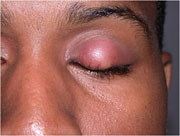Chalazion Treatments
What are the symptoms of chalazia and styes?
 About 25 percent of chalazia have no symptoms and will go away without any treatment. Sometimes, however, a chalazion may become red, swollen and tender. A larger chalazion may also cause blurred vision by distorting the shape of the eye. Occasionally, a chalazion can cause the entire eyelid to swell suddenly.
About 25 percent of chalazia have no symptoms and will go away without any treatment. Sometimes, however, a chalazion may become red, swollen and tender. A larger chalazion may also cause blurred vision by distorting the shape of the eye. Occasionally, a chalazion can cause the entire eyelid to swell suddenly.
Symptoms of a stye include:
 A red bump along the edge of the eyelid at the base of the eyelashes;
A red bump along the edge of the eyelid at the base of the eyelashes;
A feeling as if something is in your eye;
Sensitivity to light;
Eyelid tenderness;
Styes typically heal without any treatment.
Who is at risk for chalazia or styes?
Anyone can develop a chalazion or stye. If you have blepharitis — chronic inflammation of the upper and lower eyelids which become coated with oily particles and bacteria near the base of the eyelashes — you may be more likely to get a chalazion or stye.
What causes chalazia and styes?
A chalazion is caused when the opening of an oil-producing gland in the eyelid called the meibomian gland gets clogged with oil and becomes enlarged.
Styes often are caused by infected eyelash follicles.
How are chalazia and styes diagnose
Phoenix Ophthalmologists can diagnose a chalazia or stye by carefully examining your eyelid.
How are chalazia and styes treated?
It is important not to squeeze or try to “pop” a chalazion or stye. Symptoms of a chalazion or stye are treated with one or more of the following methods:
WARM COMPRESSES: Soak a clean washcloth in hot water and apply the cloth to the lid for 10 to 15 minutes, three or four times a day until the chalazion or stye is gone. You should repeatedly soak the cloth in hot water to maintain adequate heat. With a chalazion, when the clogged gland opens, you may notice increased discharge from the eye. This should improve.
ANTIBIOTIC OINTMENTS: An antibiotic ointment may be prescribed if bacteria infect a chalazion, or if a stye does not improve after treatment with warm compresses or if it keeps coming back.
STEROID INJECTIONS: A steroid (cortisone) injection is sometimes used to reduce swelling of a chalazion.
SURGICAL REMOVAL: If a large chalazion or stye does not heal after other treatments or if it affects your vision, Dr. Van Buren may need to drain it in surgery. The procedure is usually performed under local anesthesia in your ophthalmologist’s office.
Chalazia and styes usually respond well to treatment, although some people tend to have them recur. If a chalazion comes back in the same place, your ophthalmologist may suggest a biopsy (where a tiny piece of tissue is surgically removed and studied) to rule out more serious problems.
